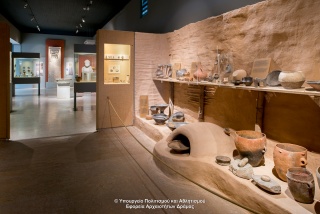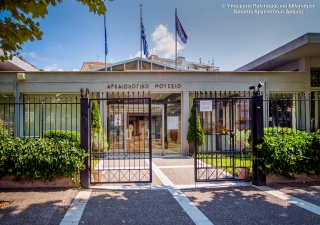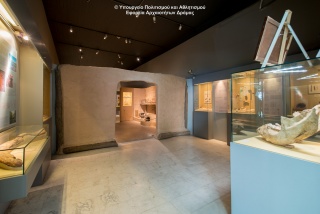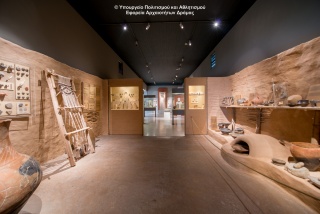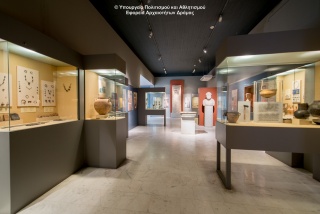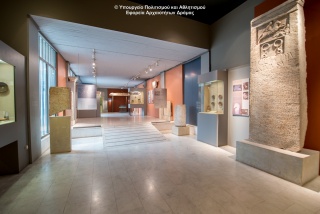Traveler's Guide
East Macedonia & Thrace
Archaeological Museum of Drama
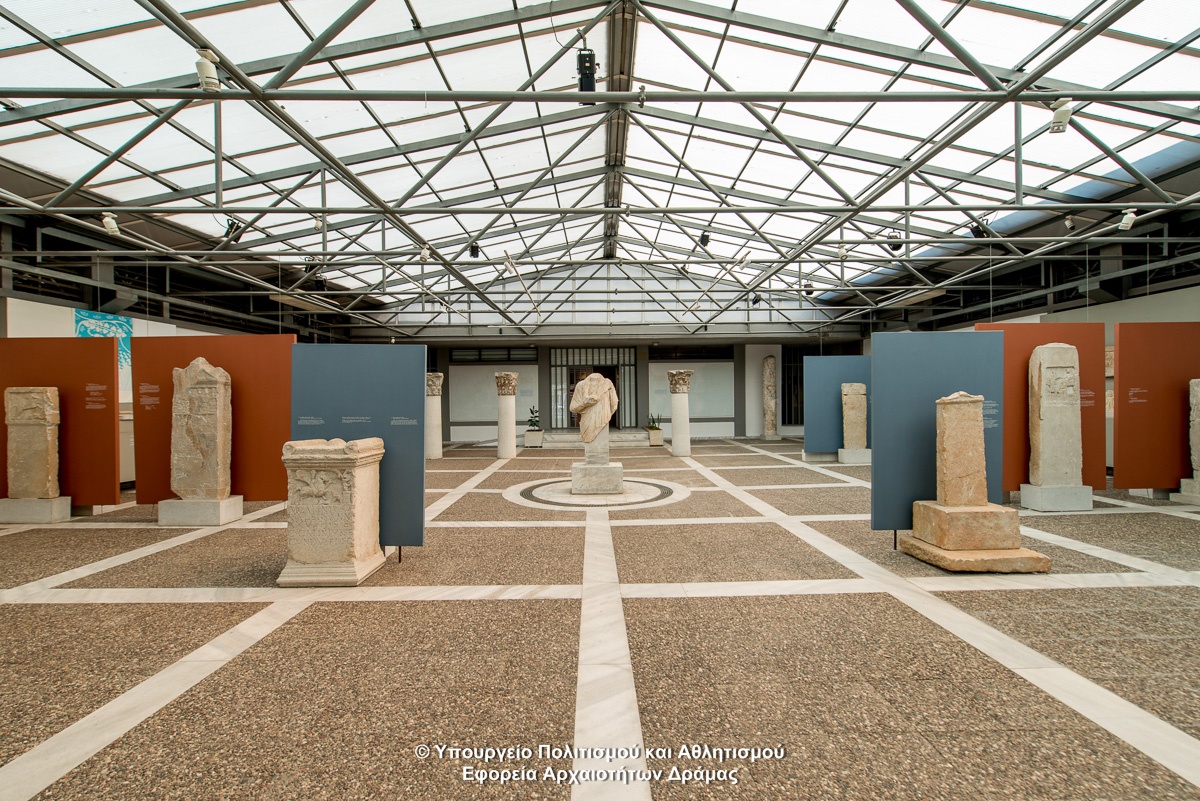
The Drama Archaeological Museum was built by the Municipality of Drama and beguested to the Ministry of Culture. In this way the local community managed to speed up the procedure for the founding of an Archaeological Museum in the town. Even though the museum is small, marks the beginning of a major effort to systematize archaelogical research and promote the cultural identity of the area.
The archaelogical finds record the gratual steps towards civilisation taken in the Drama region, firest by presenting the Middle Palaeolithic hunter-gatherers (50,000 B.C.), then the earliest Neolithic farmers and pastoralists of the Drama plain (5,500 - 3,000 B.C.) the first, patriarchal, Bronze Age communities (3,000-1.050 B.C.) and the mighty tribes of the Early Iron Age (1,050-700 B.C.). The warlike Thracian tribes that ancient Greek litterature records as living in the Drama region were descended from the warriors with iron swords whose tombs the archaeologist΄s brought to light in the Drama industrial Zone.
From the beggining of the 7th century B.C., with the founding of the southern Greek colonies on the island of the Thasos and along the coast of Macedonia, the Greek world started to penetrate inland into the area now covered by the Prefecture of Drama. Thasos, and its coastal colonies between the rivers Strymon and Nestos, opened the way for trade and cultural exchanges between the Thracian hinterland and the Greek city states on the coast. The Thasians were followed by the Athenians, later by the Macedonians and then by the Romans, as the region became increasingly urbanised. Mount Pangeon cast its shadow over the Drama plain, and loomed large in its history and its culture as a source of wealth with its gold and silver mines, and as the mountain sacred to Dionysos. The god was worshipped by Thracians and Greeks alike, as can be seen from the votive offerings recoveredfrom the sanctuary of dionysos in the ancient settlement of Drama.
The historical record makes almost no mention of the region during the Archaic and Classical periods, and archaeology has little to add due to the lack of large-scale excavations to date. It seems, however, that powerful Thracian kingdoms or autonomous city-states had not arisen. Overall, the Drama basin and its surrounding uplands entered history as a province first of the kingdom of Macedon and then of the Roman Empire, with Philippi as its principal urban centre.
Philippi remained the region's administrative and cultural capital during the Early Christian period (4th-6th century A.D.), when the Drama area flourished as a district of the diocese of Philippi.
Only after the ancient world collapsed at the end of the 6th century A.D and Philippi declined did the area acquite its own urban centre. The citadel of Drama appears during the Early Byzantine period, as the headquarters of the local military comander in control of the area. In the Late Byzantine period, the citadel and the surrounding land, though reapetdedly overrun by Latins and Bulgars, remained Byzantine from the mid 13th century until conquered by the Serbs in the mid 14th century, In 1371 it was recovered by the Byzantine emperor Manuel Paleologos, and became an administrative centre and the seat of an archibishopric until 1383, when it fell to the Ottomans.
During thr period of Turkish occupation, Drama, its population increased by Turkish colonists from Anatolia, remained the regions's principal town and administrative centre. it was, however, administratively and culturally directly dependent on constantipole,capital of the Ottoman empire and seat of the Oecumenical Patriarchate. The Greek-Orthodox communities of the Drama area, together with all the subjugated Greeks, rallied round the Patriarchate to protect their interest and organise the preservation of their ethnic identity through education.
Drama's prosperity, which in the 17th and 18th centuries was founded on the cultivation of rice and cotton, rose to new heights on the 19th century with the growing and trading of tobacco. At this time Drama and the nearby towns flourished economivally and culturally as a result of the contacts made through the tobacco trade with Western Europe.
At the end of the 19th century the region was caught up in the conflict brought on the newly-formed Bulgarians state's desire to expand into Macedonia, and paid a high price for its part in the Macedonian struggle and the Balkan Wars, In the early 20th century, with the end of the Balkan Wars in 1913, Drama and the surrounding area were incorporated into the Greek state.
Prehistory (50,000-700 B.C.)
The earliest traces of human settlement in the Prefecture of Drama come from the springs of Angitis Cave, where finds have revealed occupation by Paleolithic hunters. These finds consist of animal bones and stone tools dating to the Middle Paleolithic Age, Mousterian period (50,000 B.C).
The first Neolithic farmers and pastoralists made their appearance in the Drama basin in the sixth millennium B.C. A large number of Middle and Late Neolithic settlements attests to the area?s rising population from the sixth to the end of the fourth millennium B.C. A full picture of Neolithic culture in Drama basin is provided by finds from the excavation at the sites of Sitagri and Arkadiko. Tools, jewelery and pottery fired in high temperatures and decorated with elaborate techniques represent the earliest technical achievements of Neolithic man in the Drama region, and his cultural relations with neighbouring areas. The finds throw light on Neolithic architecture, and Neolithic man?s activities connected with food preparation and storage processes, weaving, basket-making, and also the attempt to express his personality and to communicate with the forces of nature through idols and ritual vessels. In the prehistoric settlement of Sitagri we have the first evidence of metal-working at the end of the Neolithic Age.
Other finds from Sitagri settlement give us a picture of the area?s culture during the Early Bronze Age (3,000-2,000 B.C), a time of rapid cultural transformation throughout Europe. The pottery evidence shows that at this time the Drama area developed cultural links central Europe and the North-Eastern Aegean. Late Bronze Age finds from tombs at Potami and Exohi reveal links with the and the continental Balkans and Central Macedonia, while the local Mycenaean pottery provides the first examples of contact with the Mycenaean world. Pottery, weapons, tools and jewelery from the tombs excavated in the Drama Industrial Zone confirm that the region?s links with the Balkan hinterland and central Macedonia continued into the Early Iron Age (1.050-700 B.C.)
Antiquity (700 B.C.-324 A.D.)
Surface pottery with proto-geometric decoration offers the earliest known evidence of links between the Drama region and the Thasian colonies, along the coast between the Strymon and Nestos rivers, From the late 6th and early 5th century B.C. Attic pottery appears, together with other imported items such as the Corinthian helmet found in the Kalambaki settlement. The marble bust of Dionysos From the sanctuary if Dionysos in Drama is the earliest evidence of the cult this god in the hinterland if mount Pangeon.
The Late Classical and Hellenistic Ages are represented by more abundant finds. The monumental building at kali Vrisi, the votive offerings from the sanctuary of Dionysos and the Macedonian tomb in the ancient settlements of Drama, as well as the tombstones and grave monuments from the cemeteries of other ancient settlements all attest to the economic and cultural prosperity that resulted from the region?s incorporation into the kingdom of Macedon. The hoard of 860 coins found at Potami confirms that immediately after Phillip?s conquest of the area in the 4th late 4th century B.C., the Macedonian king?s Hrd currency began to supplant the coinage of Thasos and its Colonies. Hoards of coins were often placed in tombs as grave goods, in pots that were mostly locally made.
The milestone from the ancient settlement of Kalambaki is evidence if the road building carried out in the area by the Macedonian kings. The Via Egnatia milestone from the same area confirms that this great Roman road followed an older Macedonian road from Amphipolis to Phillippi.
During the Roman Period the greater part of the present-day prefecture of Drama belonged to the province of the Roman colony of Philippi. The archaeological finds reveal a co-existence of the Greek and Roman worlds, into which the local Thracian tribes were absorbed. The bronze statuette of Zeus found at Marmaria shows that during the Roman period the Early Classical style, known throughout the Greek world, was used for statues of Zeus.
The gravestone found near the village of Grammeni records the brilliant military career of Tiberius Claudius Maximus, the Roman legionary who, fighting beside the emperor Trajan in the Dacian war, captured and behaded the last Dacian king, Decebalus.
Early Christian and Byzantine period (324 A.D.-1383 A.D.)
Architectural sculpture testifies to the quality of the art that flourished in the Drama region during the 5th and 6th centuries A.D., under the influence of the city of Philippi. Ceramics and coins confirm the Drama was inhabited and flourished continuously from Early Christian to Late Byzantine times. Excavations in the Philipi plain and the surrounding uplands have shed light on the way of life in the region?s farms and hill forts.
Byzantine monuments are few and scattered. And 11th ? 12th century chancel-screen panel from Sitagri and a mid-Byzantine stanchion from Kallifito testify to the existence of Byzantine churches in the areas. The monastic complex of St George Diasorite, which has been excavated near the village of Paleohori, belonged to the foremost monastic centre in the diocese of Drama, the Eikosifinissa monastery. One of the most interesting finds from this excavation was a stone sundial inscribed with the hours and its date of manufacture, 1069.
Remains of Byzantine Drama include the city walls, in which two building phases, the early Christian and the Byzantine, can be distinguished, the church of Agia Sofia, built in a 10th century style, and the small Paleologue church of the Archangels (Taxiarches), which has preserved valuable evidence of architecture and painting on Drama during the Byzantine period. Part of an 11th-12th century Byzantine bath has been excavated at the Agia Varvara springs. The repairs to the walls are mentioned in an inscription on a lintel dated to the 10th-11th century or according to the others the 9th century. The marble icon stand which has been used as a skylight in the century as a skylight in the church of the Presentation of the Virgin originally came from a 12th-13th century Byzantine church. Pottery, coins and jewelery from excavations within Drama and the other sites such as Xiropotamos portray public and private life during the Byzantine period. Of particular interest are two hoards of coins from Drama and Volakas containing 12th and 13th century gold and bronze bent coins.
Recent History (1383-1913)
A marble relief from the west door of the church of St. George at Krithara (built 1870-1880) placed at the entrance to the 5th room of the museum is devoted to the recent history of Drama, a painted roof (1869) from a house in Drama on the ceiling of the same room, a post-Byzantine icon of the Deisis, a decorative relief and hoards of both Ottoman and European coins create the proper ambience for an exhibition of photographs covering the monuments and history of Drama and its environs from the beginning of the Turkish period to the liberation of the city on 1913.
The photographic exhibition is divided into tree sections, referring respectively to Drama itself, to the urban centers outside the city and the mountain villages from the beginning of Turkish period until the mid 19th century, and to the monuments of the second half of the 19th century both in Drama and the surrounding area.
THE MUSEUM IS OPENFROM 08:30 – 15:00 MONDAY closed
Ticket: € 2, Reduced ticket: € 1
Amenities for the physically challenged:There is access for people with disabilities and catalog of findings in Braille system.
Service Unit: 18th Ephorate of Prehistoric and Classical Antiquities
Tel.: +302521031365
Source: http://odysseus.culture.gr/h/1/eh151.jsp?obj_id=34...
Address
2 Patriarhou Dionysiou str. , Drama, Prefecture of DramaContact Information
+302521031365
+302521031365
- Archaeological Museum of Drama
Archaeological Museum of Drama
×- Archaeological Museum of Drama_GR
- Archaeological Museum of Drama_EN
- Archaeological Museum of Drama_BG
